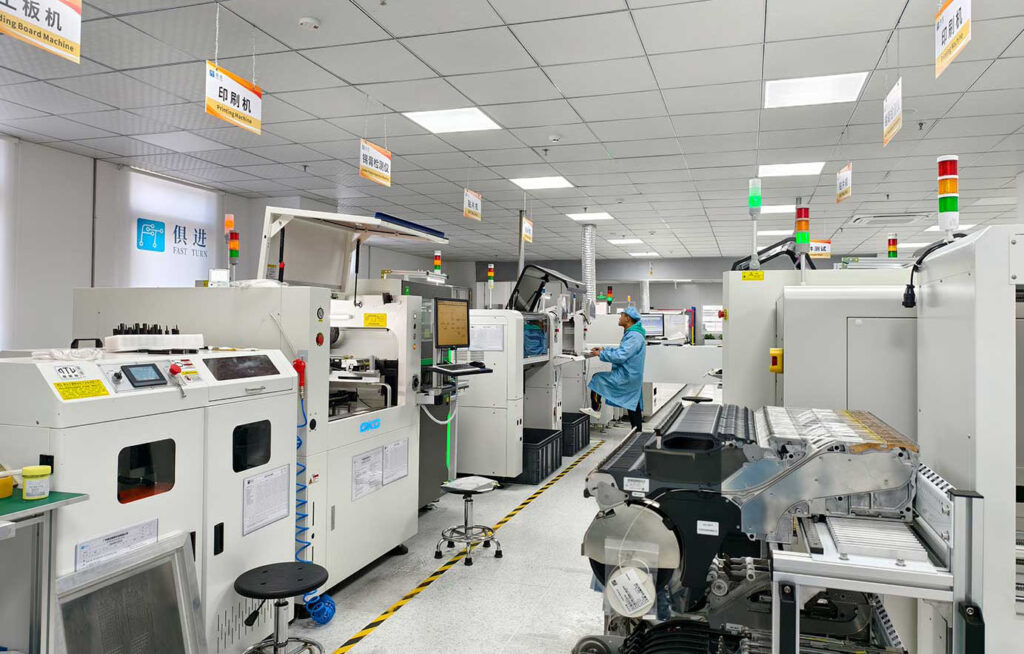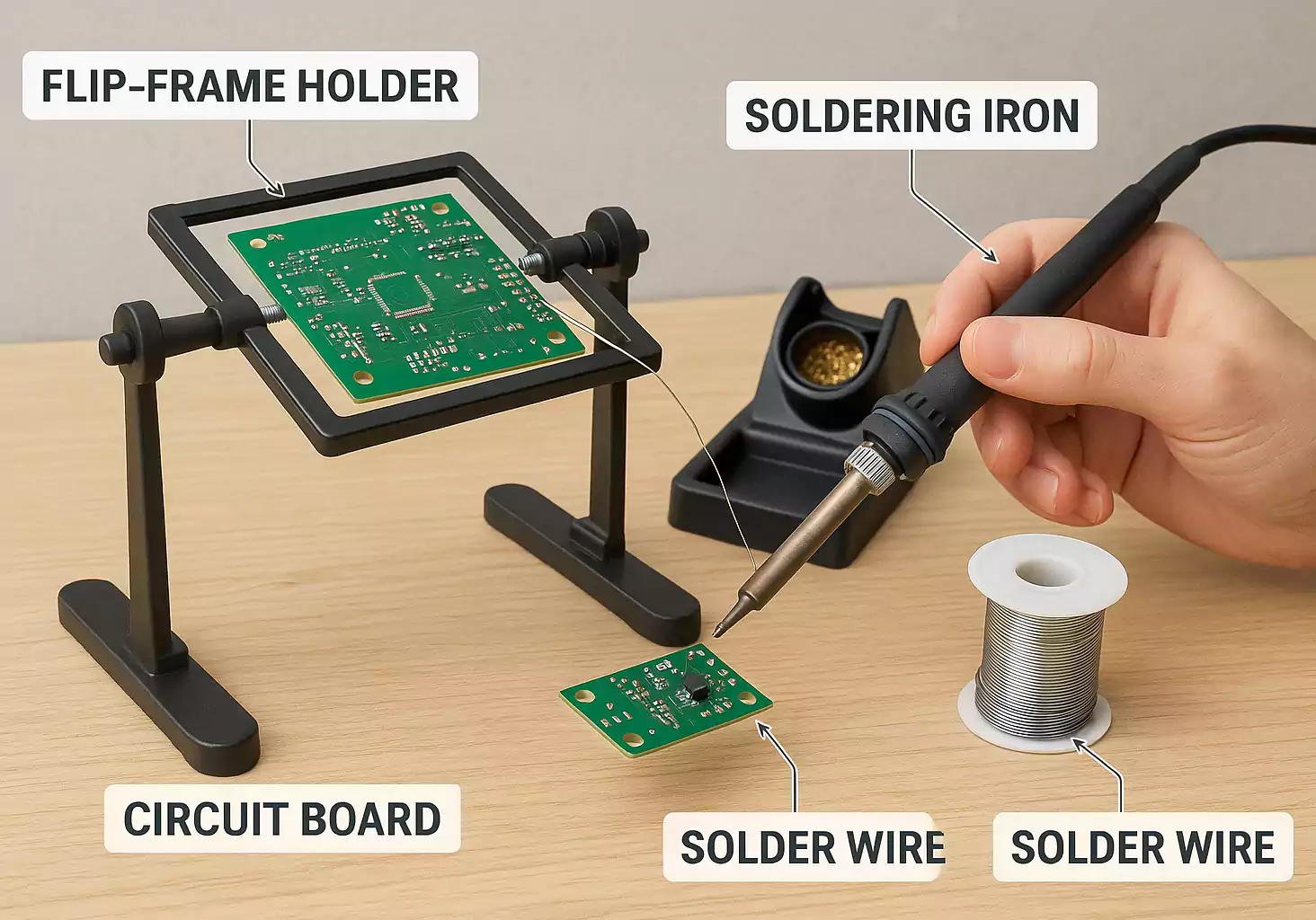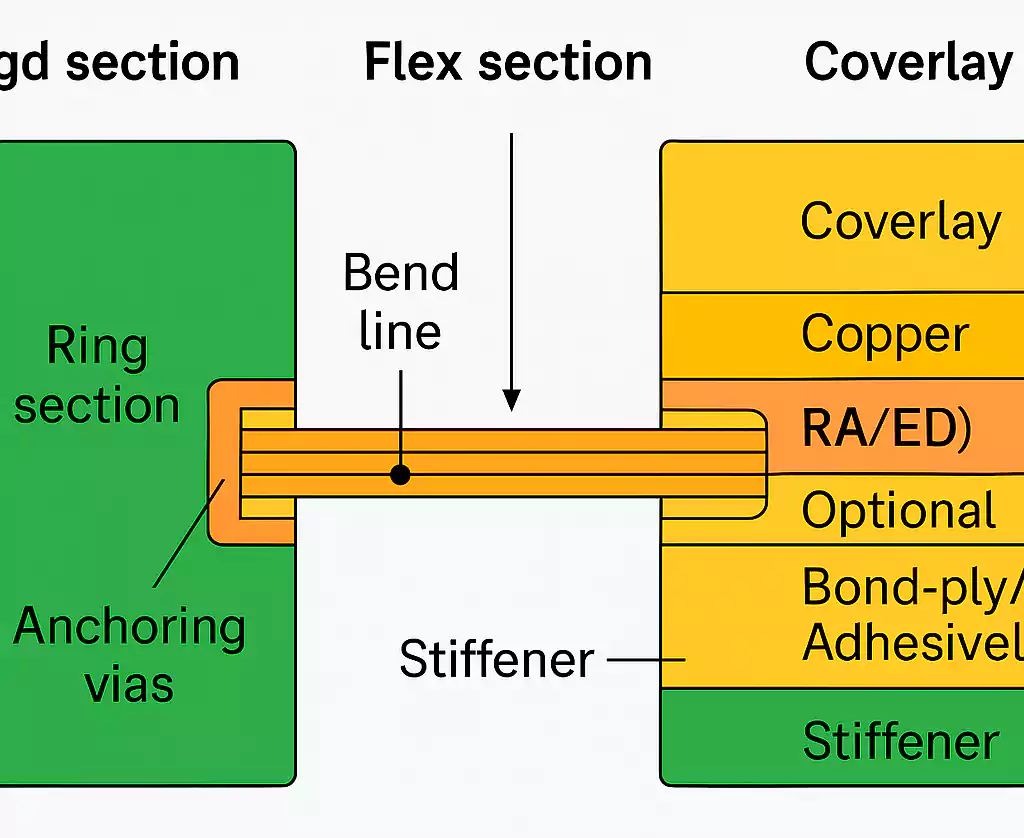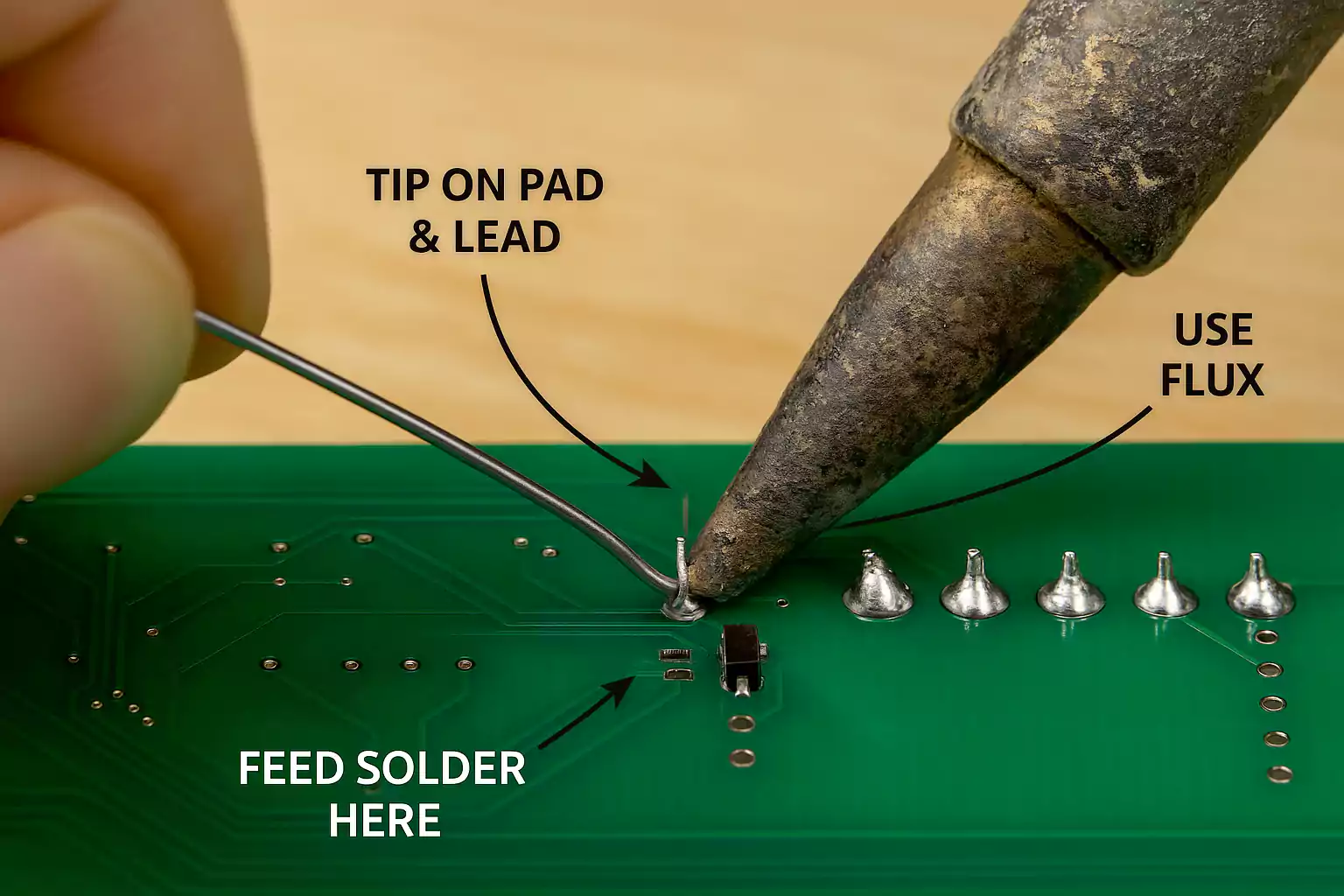Introduction
In today's fast-paced world of electronics manufacturing, the need for smaller, more efficient, and reliable devices has never been greater.
The key to achieving these goals lies in two fundamental technologies that have revolutionized how modern electronics are built: SMD (Surface-Mounted Devices) and SMT (Surface-Mount Technology).
Both SMD and SMT have become essential in the design and production of a wide range of electronic products, from smartphones and medical devices to automotive systems and telecommunications equipment. But what exactly are these technologies, and why are they so crucial for the electronics industry?
In this article, we will explore SMDs and SMTs, explaining their core principles, how they work together in electronics manufacturing, and their impact on various industries.
By the end of this guide, you'll have a solid understanding of these technologies, how they influence product design, and the significant role they play in improving the performance, cost-effectiveness, and scalability of electronic devices.
Why Understanding SMD and SMT is Crucial
For engineers, manufacturers, and designers, having a clear understanding of SMD and SMT is essential for making informed decisions about component selection, production processes, and overall product design.
Here are a few reasons why grasping these concepts is important:
- Space Efficiency: SMDs are much smaller than traditional through-hole components, allowing for more compact and densely packed electronic designs.
- Improved Durability: SMDs are more resistant to mechanical stress and vibrations, ensuring longer product lifespans, especially in high-demand industries such as automotive and aerospace.
- Cost-Effective Manufacturing: SMT enables the automation of the assembly process, leading to faster production speeds and lower labor costs, which is crucial for mass production.
Whether you are developing a new consumer gadget, designing automotive electronics, or looking to optimize production processes, understanding how SMD and SMT work is key to staying competitive in the ever-evolving electronics market.
What is an SMD (Surface-Mounted Device)?
An SMD (Surface-Mounted Device) is a type of electronic component that is designed to be mounted directly onto the surface of a PCB (Printed Circuit Board).
Unlike traditional through-hole components, which require holes to be drilled into the PCB for insertion, SMDs are placed directly onto the board's surface, which allows for more compact and efficient designs.
SMDs are a key component in the modern manufacturing of electronic products, providing both functionality and durability in smaller packages. Their small size, reliability, and ease of automation make them the preferred choice in nearly all modern electronic devices.
Key Characteristics of SMDs
To better understand why SMDs have become so essential in electronics, let’s break down their core characteristics:
- Compact Size: SMDs are much smaller than traditional through-hole components, allowing for more compact circuit designs and efficient use of space on the PCB.
- Increased Circuit Density: Because SMDs can be placed on both sides of the PCB, they allow for higher circuit density, which is especially beneficial in the development of smaller, lightweight devices.
- Improved Mechanical Stability: SMDs are surface-mounted, meaning they have a stronger connection to the PCB. This gives them better resistance to vibration, shock, and other mechanical stresses.
- Automation Compatibility: The small size and design of SMDs make them easy to handle and place using automated machinery, leading to faster, more cost-effective manufacturing processes.
Common Types of SMDs
SMDs come in a variety of shapes and sizes, each designed for specific functions in an electronic circuit. Some of the most common types of SMDs include:
| Type of SMD | Function |
|---|---|
| Resistors | Control the flow of current by providing resistance in the circuit. |
| Capacitors | Store and release electrical energy to smooth voltage fluctuations. |
| Inductors | Store energy in a magnetic field and are used in filtering applications. |
| Diodes | Allow current to flow in one direction, used for power regulation. |
| Integrated Circuits (ICs) | Contain multiple electronic circuits within a single component, such as microcontrollers or memory chips. |
Each type of SMD serves a specific role, ensuring that the electronic device performs as intended, whether it's regulating power, storing energy, or processing signals.
Major Application Areas of SMDs
SMDs have a broad range of applications in various industries due to their small size, high performance, and durability. Some of the most common application areas for SMDs include:
- Consumer Electronics: Smartphones, laptops, tablets, and other portable devices rely on SMDs for their compactness, reliability, and performance.
- Automotive Electronics: Modern cars use SMDs in everything from engine control units (ECUs) and sensors to infotainment systems and safety features like airbags.
- Medical Devices: SMDs are crucial in the design of medical equipment, including portable diagnostic tools, monitoring systems, and medical wearables.
- Telecommunications: Equipment such as routers, mobile phones, and signal processors rely heavily on SMDs for their compact, efficient design and high performance.
Advantages of Using SMDs
The use of SMDs offers several key advantages over traditional through-hole components:
- Space Savings: With SMDs, the smaller components and the ability to place them on both sides of the PCB allows for more efficient use of space, which is particularly important for smaller devices.
- Cost Efficiency: Since SMDs can be automated during the manufacturing process, they reduce labor costs and assembly time, ultimately lowering production costs.
- Better Electrical Performance: SMDs tend to have better electrical performance due to their smaller size, shorter leads, and optimized connection between the component and the PCB.
- Enhanced Reliability: The strong mechanical attachment of SMDs to the PCB provides better resistance to mechanical stress, vibrations, and thermal changes, improving the overall longevity of the device.
SMDs are critical components that enable the design of smaller, more efficient, and reliable electronic products.
Their small size, improved electrical performance, and compatibility with automated assembly processes have made them the backbone of modern electronics manufacturing.
What is SMT (Surface-Mount Technology)?
SMT (Surface-Mount Technology) is the process used to assemble electronic components, specifically SMDs (Surface-Mounted Devices), onto the surface of a PCB (Printed Circuit Board).This is a crucial part of PCB Assembly, which involves the complete process of assembling and testing the various components on the board.

Unlike traditional through-hole technology, where components are inserted into holes in the board, SMT involves placing components directly onto the surface of the PCB, significantly reducing the size of the overall assembly and improving the efficiency of the manufacturing process.
SMT has become the standard in modern electronics manufacturing because it allows for automated assembly, reduces the need for manual labor, and supports higher circuit densities. This process is crucial for producing compact and reliable devices, from smartphones to automotive electronics.
How SMT Works: The Key Steps
The SMT process involves several critical steps to ensure that SMDs are correctly attached to the PCB. These steps are designed to maximize accuracy, efficiency, and quality in the assembly process.
- Solder Paste Application: The first step in the SMT process is applying solder paste to the PCB. The paste consists of tiny particles of solder and flux, and it is applied to the areas of the PCB where the components will be mounted. This is typically done using a stencil printing method, where a stencil ensures precise application of paste.
- Component Placement: After the solder paste is applied, an automated pick-and-place machine places the SMDs onto the PCB. These machines are designed to pick up components from a reel or tray and accurately place them on the PCB at high speed. The machines use robotic arms and vision systems to ensure that each component is placed exactly where it needs to be.
- Reflow Soldering: Once the components are placed, the PCB is moved into a reflow oven, where the temperature is carefully controlled. The solder paste melts and forms strong electrical and mechanical bonds between the components and the PCB. After the solder has cooled and solidified, the components are securely attached.
- Inspection and Testing: The final step in the SMT process is inspection. Automated Optical Inspection (AOI) machines are often used to detect any misplacements, soldering defects, or other issues. The board may also undergo functional testing to ensure that all components are correctly installed and the device is working as intended.
The Advantages of SMT
SMT offers numerous benefits compared to traditional through-hole technology, making it the preferred choice in electronics manufacturing today:
| Advantage | Description |
|---|---|
| Higher Circuit Density | SMT allows for components to be placed on both sides of the PCB, maximizing the available space and enabling smaller, more compact devices. |
| Faster Production | Automated pick-and-place machines and reflow soldering lead to faster production times and reduced manufacturing costs. |
| Smaller, Lighter Products | SMT enables the production of lighter and more compact products, which is essential for modern consumer electronics and portable devices. |
| Improved Reliability | The strong, consistent solder joints formed during reflow soldering provide better mechanical stability, especially in high-vibration environments. |
| Cost-Effective | Due to automation, SMT reduces the need for manual labor, improving cost efficiency, especially in large-volume production. |
Historical Development of SMT
SMT was introduced in the 1980s as a solution to the limitations of through-hole technology. The growing demand for smaller, more efficient electronic devices, along with the need for faster and more automated manufacturing, led to the adoption of SMT.
The development of precise pick-and-place machines and reflow soldering techniques paved the way for SMT's widespread use in the electronics industry.
- 1980s - The Beginning: Early SMT systems allowed for the use of smaller components that could be placed on both sides of the PCB, which was revolutionary at the time.
- 1990s - Widespread Adoption: As technology improved, SMT became more widely adopted, particularly in the consumer electronics sector, due to its ability to reduce component sizes and improve production speeds.
- 2000s - Technological Refinement: Advances in machine precision, soldering materials, and automated inspection systems further enhanced the efficiency and reliability of SMT, solidifying its role as the industry standard.
Applications of SMT in Modern Electronics
SMT is used across nearly every electronic device manufactured today, from simple gadgets to complex machinery. Here are some key areas where SMT plays a crucial role:
- Consumer Electronics: Smartphones, laptops, tablets, and wearable devices rely heavily on SMT for their compact, reliable, and high-performance designs.
- Automotive Electronics: From advanced driver-assistance systems (ADAS) to entertainment and communication systems, SMT ensures that automotive electronics are lightweight, durable, and highly functional.
- Medical Devices: Compact medical devices such as portable diagnostic tools, patient monitors, and medical wearables depend on SMT to deliver reliable performance in small form factors.
- Telecommunications: Network equipment, mobile communication devices, and satellite technology require SMT to ensure high-density, robust designs capable of handling the demands of modern communication systems.
SMT is at the heart of modern electronics manufacturing. Its ability to support high-density circuits, automation, and faster production times has made it the go-to technology for building small, reliable, and cost-effective electronic products.
SMD and SMT: How They Work Together
In this section, we will explore how SMDs and SMT work together in the assembly process, the benefits of their collaboration, and the overall impact on electronic device production.
How SMDs and SMT Work Together in the Assembly Process
The entire process of assembling electronic devices using SMDs and SMT can be broken down into key stages. These stages demonstrate how these two technologies work hand in hand to create functional, high-quality products.
- Design and Component Selection: The first step is selecting the appropriate SMDs for the device. Engineers choose SMDs based on the specific functions they need to perform in the circuit, such as power regulation, signal processing, or energy storage.
- PCB Layout: The next step involves designing the PCB layout, where the SMDs will be placed. SMT allows for the placement of components on both sides of the PCB, maximizing space efficiency and enabling more compact designs.
- Solder Paste Application: SMT begins with the application of solder paste to the PCB. This paste is used to bond the SMDs to the PCB. The process is automated using stencil printers, ensuring precise paste application to each pad where components will be mounted.
- Component Placement: Once the solder paste is applied, SMT continues with the automated pick-and-place machines. These machines are used to accurately place the SMDs onto the solder-paste-covered pads. The precision and speed of these machines ensure that the components are positioned accurately, preventing errors in the assembly process.
- Reflow Soldering: After the SMDs are placed, the PCB enters the reflow oven, where the solder paste is heated to melt and form strong electrical and mechanical connections between the components and the PCB.
- Inspection and Testing: The final stage involves automated inspection, typically using Automated Optical Inspection (AOI) systems, to detect any issues such as misaligned components, soldering defects, or other potential issues that may compromise the functionality of the device. Functional testing ensures that the device operates as intended.
Key Benefits of SMD and SMT Working Together
When SMDs and SMT are used together in electronics manufacturing, they offer several key advantages that improve both the performance and cost-effectiveness of electronic devices.
| Benefit | Description |
|---|---|
| Space Efficiency | SMDs are much smaller than traditional components, and SMT allows for components to be mounted on both sides of the PCB. This results in more compact designs. |
| Improved Reliability | The strong, surface-mounted connections provided by SMT ensure that SMDs are firmly attached, reducing the likelihood of mechanical stress or damage. |
| Higher Production Speed | SMT is an automated process, allowing for faster assembly compared to traditional through-hole technology, which requires more manual labor. |
| Cost-Effective Manufacturing | Automation in SMT reduces labor costs and speeds up production, leading to lower overall manufacturing costs. |
| Increased Circuit Density | SMDs allow for higher-density circuits, which is essential for modern devices that require powerful functionality in a small footprint. |
| Flexibility in Design | The small size and versatility of SMDs provide engineers with more freedom in circuit design, making it easier to create complex electronic systems in compact formats. |
The Synergy Between SMD and SMT in Modern Electronics
The combination of SMDs and SMT has transformed the electronics manufacturing industry, enabling the production of smaller, faster, and more reliable devices. Here’s why this collaboration is so effective:
- Miniaturization of Devices: As consumer demand for smaller, more powerful devices increases, the ability to use SMDs with SMT has made it possible to fit more functionality into smaller spaces. SMDs’ compact design allows for higher-density circuit boards, while SMT enables fast, precise placement, making it ideal for small-scale devices like smartphones, wearables, and other portable electronics.
- Speed and Precision: SMT automates the process of placing and soldering MDs, leading to faster production cycles and more consistent results. This precision ensures that SMDs are correctly placed on the PCB, reducing errors and improving the overall quality of the device.
- Cost Reduction: The efficiency of SMT, coupled with the small size of SMDs, allows manufacturers to produce more devices in less time at a lower cost. This is especially crucial for high-volume manufacturing, such as consumer electronics, where cost-efficiency is a key factor in remaining competitive.
- Durability and Performance: The strong bond formed between SMDs and the PCB during the SMT process improves the device's mechanical stability. This durability makes SMDs ideal for industries where products must withstand vibrations, shocks, and extreme conditions, such as automotive or industrial electronics.
SMDs and SMT work together to enable the design and production of smaller, more efficient, and higher-quality electronic devices. Through their collaboration, they allow for the creation of compact and complex devices while ensuring cost-effective production and improved performance.
Applications of SMD and SMT in Electronics Manufacturing
In this section, we will explore the key industries and applications where SMD and SMT play a pivotal role, highlighting their importance in shaping modern electronics.
1. Consumer Electronics
The consumer electronics industry is one of the primary sectors that benefits from SMDs and SMT.
With the growing demand for smaller, smarter, and more powerful devices, these technologies have become essential in enabling the design and production of portable consumer products.
- Smartphones and Tablets: SMDs allow for the miniaturization of circuits, which is crucial in making smartphones and tablets compact yet powerful. SMT is used for automating the assembly of components, ensuring high-speed production and reliability.
- Wearable Devices: Devices like fitness trackers, smartwatches, and health monitoring gadgets rely on SMDs to fit small, densely packed components into a lightweight design. SMT allows manufacturers to assemble these components quickly and accurately.
- Laptops and Computers: Modern computers, from ultra-thin laptops to high-performance desktops, rely on SMDs and SMT to optimize space, improve processing power, and maintain efficient performance.
2. Automotive Electronics
The automotive industry has become increasingly reliant on SMDs and SMT as vehicles incorporate more advanced electronic systems, from safety features to entertainment systems.
These technologies play a crucial role in ensuring the reliability, functionality, and compactness of automotive electronics.
- Advanced Driver-Assistance Systems (ADAS): SMDs and SMT are used in automotive sensors, cameras, radar systems, and control units, which are key to safety technologies like automatic braking, lane-keeping assistance, and collision avoidance.
- Infotainment Systems: Modern vehicles come equipped with highly integrated infotainment systems, which use SMDs to enable features like touchscreens, Bluetooth, navigation, and voice controls.
- Electric and Hybrid Vehicles: For electric vehicles (EVs) and hybrids, SMDs are used in power management systems, battery monitoring, and charging systems, while SMT ensures the efficient assembly of these critical components.
3. Medical Devices
SMDs and SMT are also integral to the development of medical devices, particularly as the demand for portable, high-performance healthcare technologies increases. These components enable manufacturers to create reliable, compact, and precise devices for a wide range of medical applications.
- Diagnostic Equipment: Medical diagnostic tools like ultrasound machines, ECG monitors, and blood glucose meters require SMDs for the efficient handling of multiple functions in a small form factor. SMT allows for the high-speed assembly of these devices, improving production efficiency.
- Wearable Health Devices: SMDs are essential in wearable medical devices such as heart rate monitors, fitness trackers, and patient monitoring systems. The compact nature of these components is key to the small size and portability of these devices.
- Implantable Devices: Devices like pacemakers and hearing aids rely on SMDs for their compact size and precision, while SMT enables the quick, high-precision assembly of these critical devices.
4. Telecommunications
In telecommunications, SMDs and SMT play an important role in the development of the infrastructure and devices that support global communication networks. The need for smaller, faster, and more efficient components has made SMDs and SMT indispensable in this sector.
- Mobile Phones: Smartphones are the most common example of SMD and SMT in telecommunications. These devices rely on SMDs for components like processors, memory chips, and capacitors, and SMT is used to automate the assembly process.
- Networking Equipment: Routers, switches, and other networking hardware use SMDs to ensure that components like capacitors, resistors, and transistors are placed with high precision. SMT enables the quick assembly of these devices, allowing for high-volume production.
- Satellite Technology: Communication satellites rely on SMDs for their small, high-performance components. SMT ensures these components are accurately placed and soldered, ensuring the satellite's functionality in space.
5. Industrial Electronics
SMDs and SMT have also found widespread use in industrial electronics, where the demand for durable, high-performance equipment is essential for operations in sectors such as manufacturing, robotics, and automation.
- Industrial Control Systems: SMDs are used in programmable logic controllers (PLCs), which manage factory automation processes. The ability to pack more components into a smaller space makes SMDs ideal for these applications.
- Robotics: Robots used in industrial applications rely on SMDs for their control systems, sensors, and actuators. SMT ensures these components are placed efficiently, reducing the time and cost of assembly.
- Automation Equipment: From conveyors to automated assembly lines, SMDs enable the precise control of electronic systems in industrial machinery. SMT allows for the rapid production of complex automation systems.
As demand for smaller, faster, and more reliable electronic devices continues to grow, SMDs and SMT will remain central to driving innovation and improving production efficiency across the globe.
Challenges and Considerations in SMD and SMT
While SMDs and SMT offer numerous advantages in electronics manufacturing, such as miniaturization, automation, and cost-effectiveness, they also present several challenges. These challenges can affect the quality of the finished product, production efficiency, and overall costs.
In this section, we’ll explore some of the common challenges and considerations in SMD and SMT, and discuss potential solutions.
Challenges with SMDs
1. Component Size and Handling
Small Size: The tiny size of SMDs can make them difficult to handle during assembly. Smaller components are harder to manipulate, and there is an increased risk of damage during the handling and placement process.
Solution: Precision handling tools and automated pick-and-place machines are designed to handle SMDs with high accuracy. Additionally, packaging methods like tape and reel can simplify the handling process.
2. Component Damage
Physical Damage: Due to their small size and delicate nature, SMDs are more susceptible to physical damage, such as cracked leads or broken terminals.
Solution: Using high-quality SMDs and incorporating gentle handling and placement processes can reduce the risk of damage. Proper storage and handling techniques are crucial to maintain component integrity before assembly.
3. SMD Placement Accuracy
Precision Issues: Incorrect placement of SMDs can lead to poor electrical connections, leading to device malfunction or failure.
Solution: Advanced automated pick-and-place machines equipped with vision systems ensure that SMDs are placed accurately. Additionally, using AOI systems helps catch misplacement early in the process.
Challenges in SMT Assembly
1. Soldering Defects
Soldering Issues: Soldering is a critical step in the SMT process, and defects such as cold solder joints, bridging, or insufficient solder can cause connectivity issues, reduced performance, and even failures.
Solution: Using reflow ovens with precise temperature control and employing solder paste inspection (SPI) systems can minimize soldering defects. High-quality solder materials and regular maintenance of soldering equipment are also essential.
2. Component Misalignment
Misalignment during Placement: If SMDs are not correctly aligned with the pads on the PCB, this can result in short circuits, open circuits, or unreliable connections.
Solution: Pick-and-place machines with advanced alignment technology can automatically adjust to ensure proper placement. Incorporating real-time inspection systems such as AOI helps identify alignment issues before they become critical.
3. Thermal Challenges
Heat Sensitivity: Both SMDs and PCBs are sensitive to excessive heat during the SMT process. If the temperature during reflow soldering is too high, it can damage components or cause the PCB to warp.
Solution: To prevent thermal damage, reflow ovens are carefully calibrated, and the temperature profile is precisely controlled. Preheating the PCB can also help reduce thermal stress on the components.
Considerations for SMT Production
1. Cost vs. Quality
Balancing Cost and Quality: The high-speed, automated nature of SMT allows for mass production, but achieving the right balance between cost and quality can be a challenge. While automation reduces labor costs, investing in high-quality components, machines, and inspection systems can increase initial expenses.
Solution: Manufacturers must carefully evaluate production volume, the complexity of the product, and required precision. While SMT offers cost-saving advantages, investing in quality equipment and components ensures that the final product meets the required standards.
2. Material Compatibility
Soldering Material Issues: The materials used for solder paste, as well as the SMD components, must be compatible with each other and the PCB. Incompatible materials can lead to poor connections and manufacturing defects.
Solution: Using high-quality, compatible materials that meet industry standards for SMT is critical. Regular testing and certification of materials used in the process ensure that the components and solder paste work well together.
3. Environmental Considerations
Environmental Impact: The SMT process requires a variety of materials and chemicals, such as solder paste, flux, and cleaning agents, some of which can have environmental impacts.
Solution: Many manufacturers are moving toward lead-free soldering to meet regulatory standards and reduce the environmental footprint of the manufacturing process. Recycling programs and adopting eco-friendly materials also help mitigate environmental concerns.
Despite the challenges associated with SMDs and SMT, these technologies remain the cornerstone of modern electronics manufacturing. By addressing issues such as component handling, soldering defects, and thermal control, manufacturers can optimize their processes and ensure high-quality, reliable products.
Future Trends in SMD and SMT
In this section, we will explore the key future trends in SMD and SMT, highlighting the technological advancements that are set to transform electronics manufacturing.
Advancements in Materials and Miniaturization
As consumer demand for smaller, more powerful devices grows, SMDs will continue to evolve with new materials that enhance performance and durability. Flexible and printed electronics will play a key role in enabling wearable devices and flexible circuits.
Additionally, the push for higher integration will lead to System-in-Package (SiP) and System-on-Chip (SoC) solutions, integrating multiple components into smaller, more efficient packages.
This trend toward miniaturization will make it possible to pack more functionality into smaller spaces, especially in industries like healthcare and telecommunications.
AI and Automation Integration in SMT
The future of SMT lies in increased automation and the integration of AI.
AI-powered quality control systems will ensure higher precision and faster defect detection, reducing human error and improving production efficiency. Collaborative robots (cobots) will work alongside human operators, increasing flexibility on the assembly line and improving safety.
This synergy between automation and human expertise will lead to faster, more precise manufacturing processes, enabling quicker production times and reducing overall costs for high-volume manufacturing.
Sustainability and Industry 4.0
The trend toward sustainability in electronics manufacturing will drive the development of lead-free and eco-friendly materials for SMDs and SMT processes. Manufacturers will increasingly adopt green practices to reduce waste and improve energy efficiency.
Meanwhile, Industry 4.0 technologies, such as IoT-enabled equipment and big data analytics, will revolutionize the manufacturing process. These advancements will ensure the continued success and sustainability of SMDs and SMT in the rapidly evolving electronics industry.
Final Thoughts
In conclusion, SMDs and SMT are the backbone of modern electronics manufacturing. These technologies have revolutionized the design, production, and performance of electronic devices across a wide range of industries, from consumer electronics to automotive and medical devices.
By enabling smaller, more reliable, and cost-effective components, SMDs and SMT continue to drive innovation in the electronics world.







